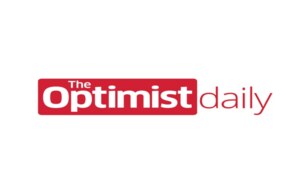“There is a great need for the introduction of new values in our society, where bigger is not necessarily better, where slower can be faster, and where less can be more.” – Gaylord Nelson
On one of our regular family Zoom calls, my aunt asked me “what habits have you adopted during quarantine that you will stick to even after things open back up.” For many of us, positive quarantine habits we will stick to include taking daily walks, driving less, checking in on our neighbors, and crafting. For others it may mean never taking child care or the joy of hugging a friend for granted ever again. On a broader community level, we also have the unique opportunity to choose how to relaunch our economies and societies. So how will not just go back, but go back to better?
For us at The Optimist Daily, this means focusing on sharing meaningful solutions to make our economic systems more sustainable, equitable, and reliable. We have discussed a wide variety of ideas ranging from circular economic models to localizing supply chains. Here are some of our top solutions.
A circular economy
The concept of the circular economy is based on reducing the use of new materials and instead recycling and repurposing those that have already been extracted. Think about houses built out of old Amazon boxes and tattered jeans, or plastic bricks made from tossed milk cartons. The concept is to take things that would otherwise end up in landfill, find novel new uses that bring new life to the materials. In the end it’s about reducing waste, lowering the ecological cost, and moving away from an extractive economic model into a sustainable or regenerative model.
In nature, waste like dead organisms are consumed by animals, fungi, and bacteria and recycled to give new life in an ecosystem. A circular economy seeks to employ these same natural regenerative processes in our man-made world. Just as old plant and animal matter feeds new growth each season, our old building materials and goods can be used to create new products, rather than crowding our landfills as we dredge new materials out of our exhausted planet. A circular economy, inspired by how nature works, from ashes to ashes and dust to dust.

One company we love which embodies this spirit of circularity is ECOR, which produces sustainable building materials designed for human and planetary health. Their material is completely free of added toxins and volatile organic compounds which can contribute to smog creation and is made from up to 100 percent recycled content. It also is entirely biobased and engineered to have 3-4 times the strength-to-weight ratio of conventional materials.
How do they do it? Their formula is a simple combination of water, fiber, pressure and heat in factories designed to be zero impact. This means using a wide variety of local materials such as cardboard boxes, newspaper, and hemp fibers. ECOR is also “Cradle to Cradle” certified meaning they embody principles of circularity, use renewable energy and recycling technologies for net zero manufacturing, and don’t have a detrimental impact on local communities, habitats, or waterways.
We spoke to Jay Potter, the Co Founder of Noble Environmental Technologies, which created ECOR. He is excited that manufacturers and consumers are finally realizing that producing goods exclusively with virgin materials is simply unsustainable.
“I’ve been excited to see the global community of government and business leaders rally around the shear logic of a circular economy, and execute realistic plans (finally) for global engagement,” he said.
ECOR has partnered with TOMS Shoes to create entirely recycled hangers and designed sustainable corporate spaces for both Starbucks and Google.
“I’ve been honored to see the ECOR solutions being held up as a best-in-class example of what the circular economy looks like and in being considered the future of global recycling,” said Potter.
Another circular company we highlighted is Lush Cosmetics, which has been employing waste reduction strategies for  almost 30 years.
almost 30 years.
The company has invested in creating solid versions of shampoo, shower gels, body lotions, and toothpaste to reduce packaging and launched its new Naked Shops in Milan, Berlin, Hong Kong, and Manchester. These stores offer packaging and label-free items, making ingredient and usage instructions available via their app, rather than printed on the packaging. They also source 100 percent post-consumer recycled content for all their plastics and 100 percent recycled paper. They also offer free face masks in exchange for returned product tubs that they clean and reuse. Our own CEO, Summers McKay loves their products and cherishes her planet-friendly coffee scrub.
Another key company in the fight against waste is Loop. This company partners with big brands like Haagen-dazs and Tide to offer product subscriptions in reusable containers. When you finish the product, you simply return the container to be refilled, waste-free. At a time when people are avoiding going out to go shopping, a delivery-based zero-waste service works for consumers and the planet.
Materials makeover
In addition to being more mindful of how and what we consume, some companies are coming up with ingenious new technologies to facilitate moving towards a circular economy. Ford and McDonald’s have teamed up to recycle old coffee waste into car parts. The process involves using coffee chaff – coffee bean skin that comes off during the roasting process – to make the plastic headlamp housing used in some of its cars. The new material uses less petroleum, lowers CO2 emissions, and reduces the use of non-renewable talc.
Scientists in Australia have also created a new kind of rubber that can be used over and over again. The product is made  from sulfur and canola oil and its sulfur bonds can be broken and reformed by applying pressure and gentle heat of about 100 °C (212 °F). Due to its unique chemical make-up, the product can be molded over and over again into tubing, coatings, bumpers, insulation, and many other things you’d normally find made of rubber. Once these products have worn out or are no longer needed, they aren’t just thrown away – the rubber can be ground up into powder, placed back into a mold, and recycled into something new.
from sulfur and canola oil and its sulfur bonds can be broken and reformed by applying pressure and gentle heat of about 100 °C (212 °F). Due to its unique chemical make-up, the product can be molded over and over again into tubing, coatings, bumpers, insulation, and many other things you’d normally find made of rubber. Once these products have worn out or are no longer needed, they aren’t just thrown away – the rubber can be ground up into powder, placed back into a mold, and recycled into something new.
The Eastman chemical plant in Kingsport, Tennessee is also ramping up research into circular plastics. They are using carbon renewal technology to break down plastic feedstocks to the molecular level before using them as building blocks to produce a wide range of materials and packaging. They are also using polyester renewal technology to transform waste polyesters into raw material that is indistinguishable from new fossil-fuel feedstock polyesters.
A movement at large
These small contributions towards creating a circular economy are part of a larger movement to reduce the waste we produce as a society and build a more sustainable future. Nobody wants to live in a world overrun with trash, and COVID-19 has forced us all to take a good hard look at what we really value in society around us. As it turns out, although we do rely on our cars and our shampoo, there are vast amounts of single use plastic trinkets that we can eliminate from our lives. Cutting out unnecessary consumption and replacing the items we rely on with more sustainable alternatives is a key step which individuals and families can make to have an immediate positive contribution to a future in which we coexist peacefully with the natural world.
A big part of this is the movement towards localizing our supply chains. Local food systems, especially, are becoming increasingly appreciated and valued, from community-supported agriculture to grow-your-own gardens, farmers’ markets, and direct-to-consumer sales by local farmers. One farm, Full Belly Farm, which offers community supported agriculture (CSA) boxes for delivery, has seen their restaurant demand plummet, but the demand for their CSA boxes has jumped by 2,000 a week. As news of large agricultural distributors dumping milk and plowing under crops coincides with reports of massive demand increases at food banks, community-oriented food systems are finding their niche as reliable, healthy options for sustainable food distribution.
A thirst for change
 The global pandemic has certainly thrust some involuntary changes into our daily lives. The challenges of working from home, caring for children, and remembering to carry PPE with us when we leave the house are out of our control, but we do have autonomy over how we make changes to better our society when this eventually comes to an end. And research shows people want change.
The global pandemic has certainly thrust some involuntary changes into our daily lives. The challenges of working from home, caring for children, and remembering to carry PPE with us when we leave the house are out of our control, but we do have autonomy over how we make changes to better our society when this eventually comes to an end. And research shows people want change.
A poll conducted by Yes! Magazine found that 90 percent of Americans do not want to go back to exactly how life was before the pandemic. 60 percent of respondents want countries to be better prepared for future crises and half want significant improvements in our health care systems. Over a third also want better pay for low-wage workers and better welfare systems. Perhaps COVID-19 will be the unwanted, yet badly needed, catalyst for the system-wide revolution we have long yearned for.
Craving a doughnut (economy)?
You may think of doughnuts as delicious deep fried snacks (we certainly enjoy them at Optimist Daily staff meetings), but  in Amsterdam, the doughnut model is not a sugary treat, but an equally crave-worthy model of economic innovation.
in Amsterdam, the doughnut model is not a sugary treat, but an equally crave-worthy model of economic innovation.
The city is basing their economic policies off a book by Oxford University’s Kate Raworth called Doughnut Economics: Seven Ways to Think Like a 21st-Century Economist. The model involves the inner ring of her donut which sets out the minimum we need to lead a good life, derived from the UN’s sustainable development goals and agreed on by world leaders of every political stripe. The outer ring of the doughnut, where the sprinkles go, represents the ecological ceiling drawn up by earth-system scientists. It highlights the boundaries across which humankind should not go to avoid damaging the climate, soils, oceans, the ozone layer, freshwater, and abundant biodiversity.
The model essentially prioritizes meeting human needs within the greater goal of protecting our planet’s ecological boundaries for a sustainable future. Amsterdam is the first city in the world to formally denounce our attachment to economic growth and laws of supply and demands, opting instead to embrace an economic model that works with the planet. It can’t be understated how big of a deal this is. Hopefully, Amsterdam can outline tangible changes to implement in accordance with the doughnut model that other cities and countries can emulate.
We at the Optimist Daily believe that economic solutions exist which work for people and the planet. Saving our Earth does not require reverting back to pre-industrial days, but it does demand that we make some significant changes to how we produce and consume goods. Employing principles of localization and circularity are critical first steps towards reducing both emissions and waste.
So what changes have you made that you will stick to after quarantine is lifted? If you’ve made conscious choices to reduce your carbon footprint, connect to your community, and support local supply chains, we encourage you to not abandon them. Many of us have been surprised to find that we enjoy many aspects of our quarantined lives. A sense of community, an urge to patron local businesses, and increased awareness of our impact in this world are some of the strange gifts of a global pandemic. Even as things reopen, we must maintain a sustainable community-oriented mindset and advocate for principles of circularity in the local and global economy.
About the Author:
 Amelia Buckley is a staff writer for the Optimist Daily and pursuing her undergraduate degree at the University of California, Santa Barbara. As a global studies major and lover of the outdoors, Amelia is passionate about crafting stories that focus on critical global issues that impact our environment and natural spaces.
Amelia Buckley is a staff writer for the Optimist Daily and pursuing her undergraduate degree at the University of California, Santa Barbara. As a global studies major and lover of the outdoors, Amelia is passionate about crafting stories that focus on critical global issues that impact our environment and natural spaces.











